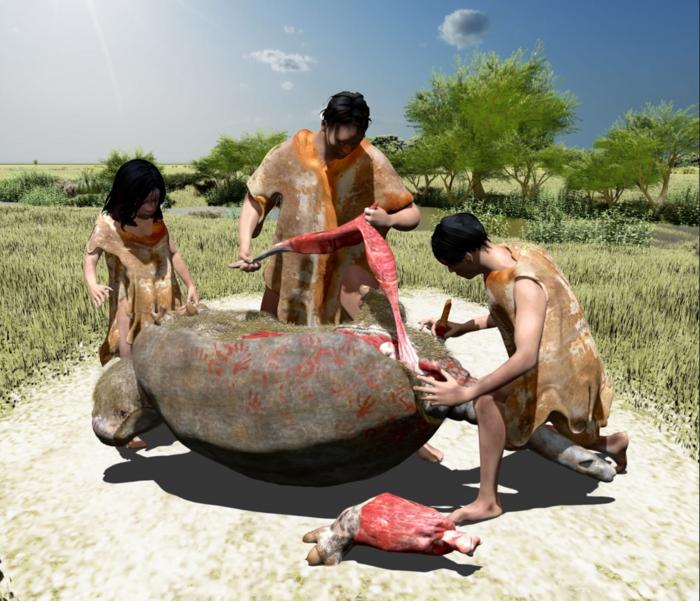Cut marks on fossils could be evidence of humans exploiting large mammals in Argentina more than 20,000 years ago, according to a study published July 17, 2024 in the open-access journal PLOS ONE by Mariano Del Papa of National University of La Plata, Argentina and colleagues.

Credit: Damián Voglino, Museo de Ciencias Naturales A. Scasso (Colegio Don Bosco), San Nicolás de los Arroyos, Provincia de Buenos Aires, CC-BY 4.0 (
Cut marks on fossils could be evidence of humans exploiting large mammals in Argentina more than 20,000 years ago, according to a study published July 17, 2024 in the open-access journal PLOS ONE by Mariano Del Papa of National University of La Plata, Argentina and colleagues.
The timing of early human occupation of South America is a topic of intense debate, highly relevant to a study of early human dispersal across the Americas and of humans’ potential role in the extinction of large mammals at the end of the Pleistocene Epoch. This discussion is hampered by a general scarcity of direct archaeological evidence of early human presence and human-animal interactions.
In this study, researchers present evidence of butchery on Pleistocene mammal fossils from the banks of the Reconquista River, northeast of the Pampean region in Argentina. The fossils are those of a glyptodont, a giant relative of armadillos, named Neosclerocalyptus. Statistical analysis finds that cut marks on parts of the pelvis, tail, and body armor are consistent with known marks made by stone tools, and the placement of these marks is consistent with a butchering sequence targeting areas of dense flesh. Radiocarbon dating indicates these fossils are around 21,000 years old, nearly six thousand years older than other known archaeological evidence in southern South America.
These results fit with other recent findings that indicate early human presence in the Americas over 20,000 years ago. These fossils are also among the oldest evidence of human interaction with large mammals shortly before many of those mammals became extinct. The authors suggest that these findings might be further supported by additional excavation at this site, further analysis of the cut marks, and more extensive radiocarbon dating of the fossils.
Miguel Delgado, the corresponding author, adds: “The study’s evidence puts into question the time frame for the first human peopling of the Americas 16,000 years ago”
#####
In your coverage please use this URL to provide access to the freely available article in PLOS ONE:
Citation: Del Papa M, De Los Reyes M, Poiré DG, Rascovan N, Jofré G, Delgado M (2024) Anthropic cut marks in extinct megafauna bones from the Pampean region (Argentina) at the last glacial maximum. PLoS ONE 19(7): e0304956.
Author Countries: Argentina, France, China
Funding: Work leading to this publication was funded by grants from National Natural Science Foundation of China (#31771393), Wenner-Gren Foundation for Anthropological Research (USA) Grant/Award number 9391, Consejo Nacional de Investigaciones Científicas y Técnicas (CONICET), Facultad de Ciencias Naturales y Museo Universidad Nacional de La Plata (FCNyM, UNLP), INCEPTION program (Investissement d’Avenir grant ANR-16-CONV-0005) and ERC-2020-STG – PaleoMetAmerica – 948800. The funders had no role in study design, data collection and analysis, decision to publish, or preparation of the manuscript.
Journal
PLoS ONE
Method of Research
Observational study
Subject of Research
Animals
Article Title
Anthropic cut marks in extinct megafauna bones from the Pampean region (Argentina) at the last glacial maximum
Article Publication Date
17-Jul-2024
COI Statement
The authors have declared that no competing interests exist.



